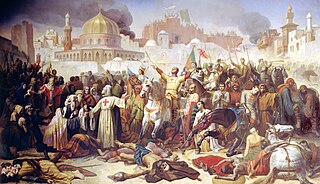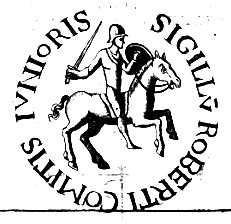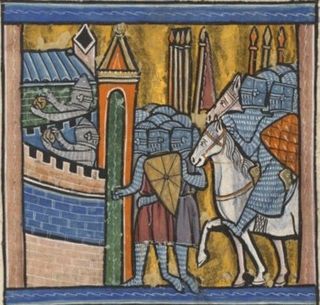Related Research Articles
The 1090s was a decade of the Julian Calendar which began on January 1, 1090, and ended on December 31, 1099.

Year 1099 (MXCIX) was a common year starting on Saturday of the Julian calendar.
The 1100s was a decade of the Julian Calendar which began on January 1, 1100, and ended on December 31, 1109.

Year 1101 (MCI) was a common year starting on Tuesday of the Julian calendar. It was the 2nd year of the 1100s decade, and the 1st year of the 12th century.

Year 1176 (MCLXXVI) was a leap year starting on Thursday of the Julian calendar, the 1176th year of the Common Era (CE) and Anno Domini (AD) designations, the 176th year of the 2nd millennium, the 76th year of 12th century, and the 7th year of the 1170s decade.

Year 1190 (MCXC) was a common year starting on Monday of the Julian calendar.

Year 1096 (MXCVI) was a leap year starting on Tuesday of the Julian calendar.

Year 1105 (MCV) was a common year starting on Sunday of the Julian calendar.

The First Crusade (1096–1099) was the first of a series of religious wars, or Crusades, initiated, supported and at times directed by the Latin Church in the medieval period. The objective was the recovery of the Holy Land from Islamic rule. While Jerusalem had been under Muslim rule for hundreds of years, by the 11th century the Seljuk takeover of the region threatened local Christian populations, pilgrimages from the West, and the Byzantine Empire itself. The earliest initiative for the First Crusade began in 1095 when Byzantine emperor Alexios I Komnenos requested military support from the Council of Piacenza in the empire's conflict with the Seljuk-led Turks. This was followed later in the year by the Council of Clermont, during which Pope Urban II supported the Byzantine request for military assistance and also urged faithful Christians to undertake an armed pilgrimage to Jerusalem.
Kilij Arslan ibn Suleiman (1079–1107) was the Seljuq Sultan of Rum from 1092 until his death in 1107. He ruled the Sultanate during the time of the First Crusade and thus faced the earliest attacks from Christian forces. He also re-established the Sultanate of Rum after the death of Malik Shah I of the Seljuk Empire and defeated the Crusaders in three battles during the Crusade of 1101. Kilij Arslan was the first Muslim and Turkish commander to fight against the Crusaders, commanding his horse archers as a teenager.
Kilij Arslan II or ʿIzz ad-Dīn Kilij Arslān ibn Masʿūd was a Seljuk Sultan of Rûm from 1156 until his death in 1192.

Robert II, Count of Flanders was Count of Flanders from 1093 to 1111. He became known as Robert of Jerusalem or Robert the Crusader after his exploits in the First Crusade.

The Battle of Dorylaeum took place during the First Crusade on 1 July 1097 between the crusader forces and the Seljuk Turks, near the city of Dorylaeum in Anatolia. Though the Turkish forces of Kilij Arslan nearly destroyed the Crusader contingent of Bohemond, other Crusaders arrived just in time to reverse the course of the battle.

The Crusade of 1101 was a minor crusade of three separate movements, organized in 1100 and 1101 in the successful aftermath of the First Crusade. It is also called the Crusade of the Faint-Hearted due to the number of participants who joined this crusade after having turned back from the First Crusade.

The siege of Nicaea was the first major battle of the First Crusade, taking place from 14 May to 19 June 1097. The city was under the control of the Seljuk Turks who opted to surrender to the Byzantines in fear of the crusaders breaking into the city. The siege was followed by the Battle of Dorylaeum and the Siege of Antioch, all taking place in modern Turkey.

Ida of Austria was a Margravine of Austria by marriage to Leopold II of Austria. She was a crusader, participating in the Crusade of 1101 with her own army.

The siege of Xerigordos in 1096, often Xerigordon in modern historical literature, pitted 6,000 Germans of the People's Crusade under Reinald of Broyes against the Turks commanded by Elchanes, general of Kilij Arslan, the Seljuk Sultan of Rûm. The crusader raiding party captured the Turkish fort of Xerigordos, about four days' march from Nicaea, in an attempt to set up a pillaging outpost. Elchanes arrived three days later and besieged the crusaders. The defenders had no water supply, and after eight days of siege, they surrendered on September 29. Some of the Crusaders converted to Islam, while others who refused were killed.

The Battle of Civetot was fought between the forces of the People's Crusade and of the Seljuk Turks of Anatolia on 21 October 1096. The battle brought an end to the People's Crusade, before the Princes' Crusade.
The following is an overview of the armies of First Crusade, including the armies of the European noblemen of the "Princes' Crusade", the Byzantine army, a number of Independent crusaders as well as the People's Crusade and the subsequent Crusade of 1101 and other European campaigns prior to the Second Crusade beginning in 1147.
The battles of Heraclea were a series of battles fought during the Crusade of 1101 between Crusaders led by William II, Count of Nevers and the Sultanate of Rum led by Kilij Arslan I. Both battles resulted in a Turkish victory.
References
- ↑ Runciman, Steven (1987). A history of the Crusades, vol. 2: The Kingdom of Jerusalem and the Frankish East, 1100-1187. Cambridge: Cambridge University Press. pp. 23–25. ISBN 052134770X. OCLC 17461930.